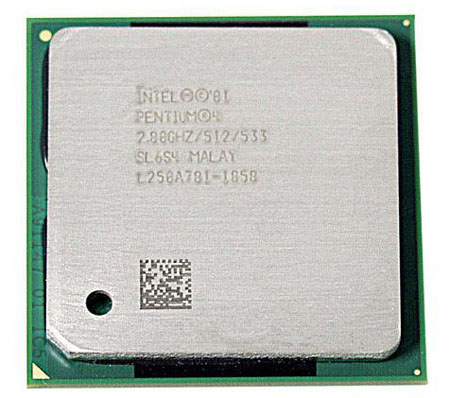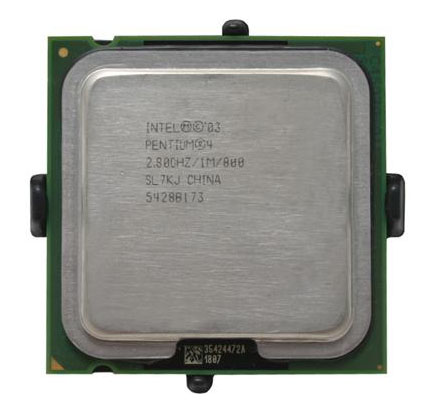Processor Obfuscation and You: An Update on AMD and Intel CPUs
by Kristopher Kubicki & Jarred Walton on May 17, 2005 12:00 PM EST- Posted in
- CPUs
Intel Processors
With AMD out of the way, we'll move on to the code names and features of all the currently shipping Intel processors. We only have two platforms this time - not counting the server and mobile options. The good news is that there isn't quite as much overlap in the Intel world. Sure, we have numerous chips running at similar clock speeds, but with a few exceptions, each model number explicitly defines one set of features. Where AMD has four different Athlon 64 3400+ chips (including the obscure 2.2 GHz 512K 939 chip that is limited to an 800 MHz HyperTransport link), the Intel Pentium 540J is always a 3.2 GHz Prescott core for socket 775. Let's take a look at the shipping cores.| Intel Processors | ||||
| Core Name | CPU Name | L2 Cache | Process | Notes |
| Socket 478 | ||||
| Northwood | Celeron | 128K | 130nm | No SSE3 |
| Northwood | Pentium 4 | 512K | 130nm | No SSE3 |
| Prescott | Celeron D | 256K | 90nm | |
| Prescott | Pentium 4 | 1024K | 90nm | |
| Socket (LGA) 775 | ||||
| Prescott | Celeron D | 256K | 90nm | Partial EM64T |
| Prescott | Pentium 4 5xx | 1024K | 90nm | Partial EM64T |
| Irwindale | Pentium 4 6xx | 2048K | 90nm | |
| Cedar Mill | Pentium? | 2048K | 65nm | |
| Smithfield | Pentium D | 2 x 1024K | 90nm | Dual Core |
| Presler | Pentium D? | 2 x 2048K | 65nm | Dual Core |
Socket 478

For 2.8 GHz and above, we'd say look to overclocking first (if you haven't already), and if you're still unsatisfied, you'll probably want to ditch the platform rather than investing more money. Those running anything less than a 2.6 GHz chip might consider purchasing one of the faster chips before they entirely disappear, but you're basically delaying the inevitable. Unlike AMD, however, socket 775 doesn't offer a whole lot in the way of improved performance. DDR2 and PCI Express won't be available without switching to socket 775, but they're not truly necessary. We wouldn't spend a whole lot of money on a new AGP card, but if you already have something reasonably powerful, you're probably best off waiting a bit longer to upgrade from anything sporting an 865PE or 875P chipset (or else jumping ship and purchasing an AMD system).
Socket 775

The next Intel core is Smithfield, which received its official name with the recently released Pentium D processors - although really, we should call them "the recently announced" Pentium D processors, as they are not yet available for purchase at any retailers. (That should hopefully change in the next month.) Smithfield processors will use 8xx model numbers to differentiate them from their single core relatives. Like the 6xx series, the 8xx processors all feature support for EIST and EM64T, but they add a second core. Multitasking in particular stands to benefit a lot from the addition of a second core, but for running a single-threaded application (without a bunch of other processes), a higher clocked 5xx or 6xx chip is still going to be faster. The Extreme Edition also has HyperThreading enabled, allowing the execution of four simultaneous threads. Unfortunately, HyperThreading is not always beneficial, as there are cases where the Pentium Extreme Edition 840 is outperformed by the Pentium D 840.
There are drawbacks for Pentium D: heat output and power consumption. The power draw of a Pentium D system scales rapidly with increased clock speeds. In order to combat this, Intel has been forced to reduce the shipping clock speeds of their dual core chips. This means that while 3.6 and 3.8 GHz parts are available for the 5xx and 6xx lines, the fastest 8xx chip is currently 3.2 GHz. Sure, the relative power draw of Pentium D may only be 15% higher than Pentium 4, but when you're talking about 100+ Watts, removing an additional 15% can become difficult. You could also say that the lower clock speeds tie into the more affordable prices that Intel is presenting. Where AMD is essentially releasing dual core variants of their 3500+ and higher processors, Intel is only releasing 2.8 to 3.2 GHz parts. If AMD had 1.8 and 2.0 GHz dual core parts, the prices might be quite a bit lower.
Even with these drawbacks, the Pentium D is still an attractive part for many people. The biggest problem is that the Pentium D is not yet available for purchase, and while it uses the same socket (LGA 775), you need a motherboard with one of the new 945/955 Intel chipsets. (The NVIDIA nForce 4 SLI chipset will also work, provided that the motherboard manufacturer has designed their board properly.) If you're serious about purchasing a new computer and you're set on an Intel system, we would strongly recommend waiting for the new motherboards and processors to become available.










55 Comments
View All Comments
flatblastard - Tuesday, May 17, 2005 - link
"you're probably best off waiting a bit longer to upgrade from anything sporting an 865PE or 875P chipset (or else jumping ship and purchasing an AMD system)."I would like to know which one of you, Kris or Jarred, decided to throw in that last little tidbit. While I agree that it's probably best to wait on upgrading from 865pe/875p, was that last part really necessary? I was really enjoying the unbiased explanations right up until that moment. You should save comments like that for the conclusion section, where your opinions belong.
JustAnAverageGuy - Tuesday, May 17, 2005 - link
:thumbsup;IntelUser2000 - Tuesday, May 17, 2005 - link
Irwindale is Xeon variant of Prescott 2M, Prescott 2M is the code name for... Prescott 2M.ta2 - Tuesday, May 17, 2005 - link
I have a Socket 754 Sempron 2800+. CPU-Z gives me this information:Codename: Palermo
Technology: 90nm
Revision: DH8-D0
This processor DOES NOT have SSE3 as stated in your article.
Rand - Tuesday, May 17, 2005 - link
" At the time of publication, the only Paris Sempron comes in the form of the Sempron 3100+"The Paris core Sempron's are also available at 2600+ and 2800+, and available in 128KB varians not just 256K variants.
I've no idea on 3000+ varients, but I'd be surprised if there weren't some Paris 3000+ models out there.
I also didn't see any mention made of the S754 Athlon64 3300+. Granted it would appear to be available only to OEM's and that in relatively small quantities but still worth mentioning.
(2.4GHz/256K Winchester core).
Given the above you should also mention that the Winchester is available in 256K varients... at least in the one model only.
JarredWalton - Tuesday, May 17, 2005 - link
17 - the "partial" was to indicate that not all Prescott or Celeron D chips have EM64T. I probably should have made that more clear. Basically, I didn't want to put "EM64T" and have people assume that *all* Prescotts have it. They do, of course, but it's only enabled on the +1 models.BlvdKing - Tuesday, May 17, 2005 - link
I also have a 'CG' Clawhammer with 1mb L2 cache.ElFenix - Tuesday, May 17, 2005 - link
thanks!pxc - Tuesday, May 17, 2005 - link
Kristopher or Jarred: You labelled the Celeron D and P4 5xx columns "Partial EM64T". What is "partial" about it?I happen to have a P4 551 I got in December and there is nothing "partial" about EM64T support on it.
icarus4586 - Tuesday, May 17, 2005 - link
"Hammer chips (Sledgehammer and Clawhammer) are the oldest in the Athlon 64 fleet, and still us the "C0" stepping."There are also newer CG stepping models. (Clawhammer at least, I have one)